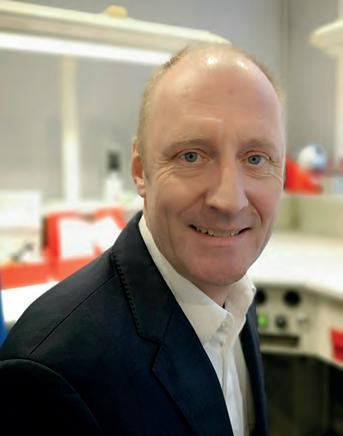
12 minute read
l DIGITAL TECHNOLOGY: BLENDER4DENTAL, THE STORY CONTINUES… I BY ANDREW WHEELER
Blender4Dental,
the story continues…
Advertisement
By Andrew Wheeler I Precision Ceramics
Much has happened since the last article I wrote on the ‘new kid on the block’, And as we have come to expect nothing in digital dentistry stays still for very long. So where are we now with this new progressive software that has gained so much traction in the profession?
The biggest leap forward for this software has been the launch of the Crown and Bridge module, completing the suite that started with the Model module. As per the other parts of Blender4Dental the module, once purchased, is free of any locked in contracts, no yearly charges, and free updates. It covers all aspects of crown and bridge work that you would expect, the only limit is one’s own knowledge.
A helpful addition is the weekly zoom meeting that Michael and Wolf, the architects of B4D, hold. They explore many areas of the software that increase the user experience in a clear and easy to understand way. This alongside a fantastic online community, accredited instructors and video tutorials cover all you need to get designing.
Another interesting development which has been launched is the VertXsplit model system. This allows users to purchase a base and create a printed split model that locates it, much the same as a conventional model tray system. This highlights the beauty of Blender4Dental, using the latest software but retaining the tried and tested methods, designed by technicians for technicians.
The development of the software continues with more implant companies allowing their libraries to be used, expanding the variety available to users. The open-source theme runs alongside the software with users able to create their own tooth libraries and integrate them with the software, utilizing clear and easy to understand video tutorials.
For many years technicians have developed their own workflow and technical abilities to meet their clients demands, and in an interesting way this software allows users to maintain that individual artistic side.
Yes, there is a learning curve and that might put some off, it is tempting to compare it to other popular CAD programs, but that limits the scope of the software in my opinion. It should be looked upon as a rethink of how we manufacture appliances in the digital world, allowing us to still express ourselves through our work, something we have been doing for decades. Once the basics have been mastered, the knowledge of how CAD programs operate become understandable, which in turn gives the power into the hands of the technician. It is understandable that many technicians are not aware how their CAD software operates as the user interface hides most of the workings, with B4D you get to delve into a world of vertices, surfaces, and edges. You get to inhabit the fascinating world of 3d design, moving at will between various stages and not constrained to a pre-set workflow. Understanding why things go wrong and know how to fix them.
It would be remiss of me not to mention an important draw and that is the cost of this software. Blender for Dental is low cost, but just as powerful, it allows smaller laboratories to make the move into digital dentistry without the large financial outlay. Leaving behind wax knifes and plaster models dental professionals can purchase the software themselves and learn how to become proficient in computer aided design, placing themselves in a very valuable position as the industry changes.
As more dental laboratories convert to digital it is hard to stand apart from the crowd. Blender4Dental can certainly help retain the personality we put into our work, as well as meet the challenges the industry is facing.
You could say I am a fan of this software, understanding the digital design process in depth has allowed me to offer services that previously were not a consideration in my laboratory. Being able to guide people through the steps of this software has been a real privilege, and I look forward to seeing what the future holds.
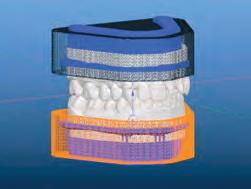

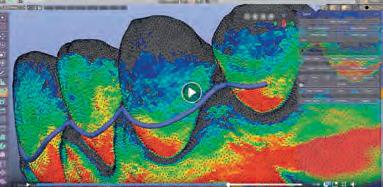
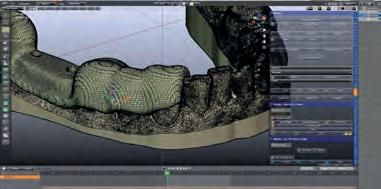
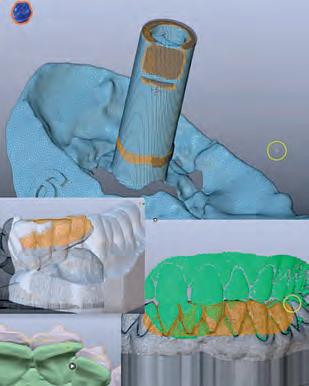
Learn more about Blender for Dental, contact Andrew Wheeler @ precision_ ceramics@yahoo.co.uk or visit https:// www.blenderfordental.com
EXECUTIVE LEADERSHIP SERIES Be a Futuristic LEADER

By Nicki Rowland

In last month’s edition, Nicki Rowland, Director of Practices Made Perfect and co-owner of The Exceptional Leadership Academy, discussed the ‘Art of Listening’ and its importance in leading your team to success. In this article, she explores being a futuristic leader and why giving your team a common focus keeps your laboratory ahead of your competition.
FUTURISTS THINK STRATEGICALLY All leaders need to take time to centre themselves, look to the future and plan ahead. Assess the marketplace of the future, your clients’ desires, your competitors’ activity and the wider economy. In recent times, well-known companies such as Comet and Blockbusters, have failed to anticipate change and ‘pivot’ when required. Their demise can be partly attributed to the fact that they did not ‘flex and bend’. Covid-19 has put even more pressure on labs. The need to be agile and think strategically is paramount.
Whether your Laboratory is large or small, we all need to produce results. Objectives and goals need to be met irrespective of the leadership role you hold. Achieving success is a journey and it is vital to take your team on that journey with you to achieve results. Imagine any great football manager. How do they ensure that their team walks away with the trophy? Well, they are on a mission to win and have a carefully planned strategy to make sure that they are the winners. In the same way, your need to have a written ‘purpose’ for the business, a mission statement and SMART business objectives to focus team members’ minds on the bigger picture. A collaborative, cohesive approach within your team is essential to underpinning success and is a concrete foundation on which to take your business from A to B.
FUTURISTS ASK QUESTIONS A leader asks questions even when they think they know the answers. Channels of communication can be unlocked and discussions facilitates by using ‘open’ questions. Open questions start with ‘what’, ‘why’ ‘who’ ‘how’ or ‘when’. They could be used to ask ‘What do you feel you have done particularly well recently?’, ‘Why is change such a hurdle to you?’, ‘Who would you recommend for the job?’, ‘How do we plan for the future?’ and ‘When would be the best time for us to get our heads together?’ and so on. Questions are also a great chance to challenge your people to take a renewed look at a problem and assist them in thinking about the results they strive to achieve.
Trust is the basis for a thriving, productive culture in your business. With trust, you can ask open questions freely, instigate ‘positive conflict’, generate commitment and hold people to account in your business. Without trust, progress slows, simple processes become disputed and decision-making is handled with caution. I have learned from experience that trust is fostered from finding courage. Sometimes, as leaders, we feel that we need to be hardy, totally resilient and ‘The Oracle’ in the workplace. Yes, your team needs a strong and resourceful leader but they also need to feel your vulnerability. As I talked about previously,openly discussing your susceptibilities can take guts but it allows others to recognise that you are human too. Digging deep and having open and honest conversations initiates sharing of experiences and following through on tasks.
FUTURISTS EMBRACE CHANGE A sense of urgency is crucial for those of us who are driving change in ourbusinesses. John Kotter is the founder of Kotter International and a professor at Harvard Business School. His books include Leading Change, in which he outlines an 8-stage u

model of change. The first step of Kotter's model of change is establishing a sense of urgency. Kotter argues that “Establishing a sense of urgency is needed in the change process and helps managers of companies and leaders of change to fight against complacency”. When team members exhibit complacency, it is often because they are content with the status quo. When employees are complacent, questions such as ‘Why do we have to change anything when the old way still works?' or 'Why make a change when we do not know if it will work or not?' are commonplace. Urgency is the polar opposite of complacency. It helps teams to recognise why change is needed. Always sell the benefits of change to your team to gain their ‘buy-in’. I would suggest comparing your ‘old world’ with your ‘new world’ on a flip chart and then it soon becomes evident that the difference is not as significant as once thought.
FUTURISTS LOOK AT THE BIGGER PICTURE Jack Welch was an American business executive who said “Good business leaders create a vision, articulate a vision, passionately own a vision and relentlessly drive it to completion”. He talks about visionary leadership being fostered by inspiring and motivating people to pursue a long term goal. For me it is also about looking to the future and being ‘a Futurist’. I would say that there are 7 key qualities of a being futuristic leader:1 Focused Determined and tenacious. They keep their attitude above the line and their eyes on the horizon.
2 Imaginative Visualising your future business and then carving out a path to achieve the ‘bigger picture’.
3 Innovative Introducing new ideas, projects and initiatives. It is all about thinking ‘outside the box’.
4 Strategic thinker The ability to plan ahead, set goals and inspire your team to achieve them.
5 Intelligent risk taker Being prepared to take a ‘calculated risk’ for the greater good of your team and the business.
6 Skilled communicator Translating your future vision to conjure up a tangible picture of what is achievable in the mind of each team member.
7 Resilient Standing firm and being determined to implement change against adversity.
In summary, futurists inspire, transform and ultimately change industries.
FUTURISTS HAVE A ZEST FOR LIFE Your behaviours, values and actions will be observed by your team – you are their ‘yardstick’. You are setting the precedent for conduct and performance in your practice. If your standards or attitude slips, your people will let theirs slip too. If you are open and honest, your team will follow suit. Enjoy your workplace and have fun and your team will enjoy working with you. Steve Jobs says “Be a yardstick of quality. Some people are not used to an environment where excellence is expected”. So, ask yourself ‘What kind of yardstick am I?’ Make your expectations of quality clear, live those expectations, have a zest for life and become a yardstick worth being measured against. Be a leader who gets a complete buzz from seeing their team flourish and grow.
As American author, Norman Vincent Peale, once said “If you have zest and enthusiasm, you attract zest and enthusiasm. Life does give back in kind.”
A Word from Nicki
I hope you have all enjoyed reading this article. If there is anything I can help you with… personal coaching, remote training or just a quick word of advice, I’m happy to help. Contact me on info@pmp-consulting.co.uk In the meantime, look out for my ‘Certificate in Business Recovery – The 5R’s to Recovery’, 7 hours of on-line, enhanced CPD in which I teach you to regroup your team, resolve issues in your lab, rebuild your business, retrain your team and ensure resilience against adversity in the future.
Go to ela.thinkific.com and apply the 40% discount code dentistrecovery40.
For more information, contact me at
info@ela.team
ABOUT NICKI ROWLAND
Nicki has lived and breathed practice management since opening Perfect 32 Dental Practice in East Yorkshire in 2005.
For over 10 years, Nicki nurtured her team to achieve exemplary standards in both clinical and customer service based areas of work and as a result the practice won countless awards. These include The National Training
Awards for Yorkshire and Humber
in 2010, as well as being a national finalist in the SME category. In 2011, Perfect 32 won The Training Business of the Year Award at the local Chambers of Commerce Awards and Nicki herself was awarded Practice Manager of the Year by the UK’s Association of Dental Administrators and Managers (ADAM) in 2012.
In 2014, Nicki set up her own business, Practices Made Perfect. She has also recently co-founded The Exceptional Leadership Academy (ELA). SPECIALISMS: • Strategic Business Development • Leadership and Management • Change Management • Dental Legislation, including CQC • and GDPR requirements • Dental Ethics • Complaints Handling • Staff Development • Recruitment in Practice • Exemplary Customer Service

KEEP PACE WITH DENTAL IMPLANTOLOGY
l As a dental technician, any additional training or learning is never wasted. With expectations from clients and their patients continuing to rise, producing high-quality, long-lasting prostheses is as vital now as ever before.
The Association of Dental Implantology (ADI) recognises the need for accessible educational resources – when you become a member of the ADI, you’ll have access to a variety of different learning services, such as two highly regarded journals, free attendance to the biennial ADI Members’ National Forum and free ADI study clubs. Plus, with access to the ADI Members’ Only Facebook Group, you can share ideas and network with other dental professionals.
By being an ADI member, you are more than just part of an association – you are part of a close-knit community of peers, with support systems always readily available. With the ADI at your back, you can keep pace with the everevolving nature of dental implantology.
For more information about the ADI, or to become a member, get in touch with the ADI team, or visit the website today! www.adi.org.uk


